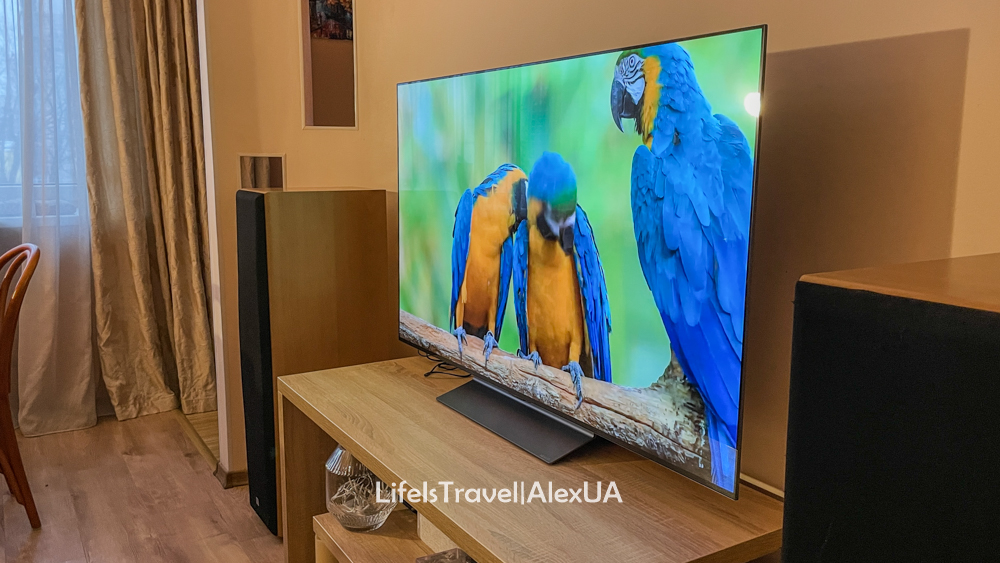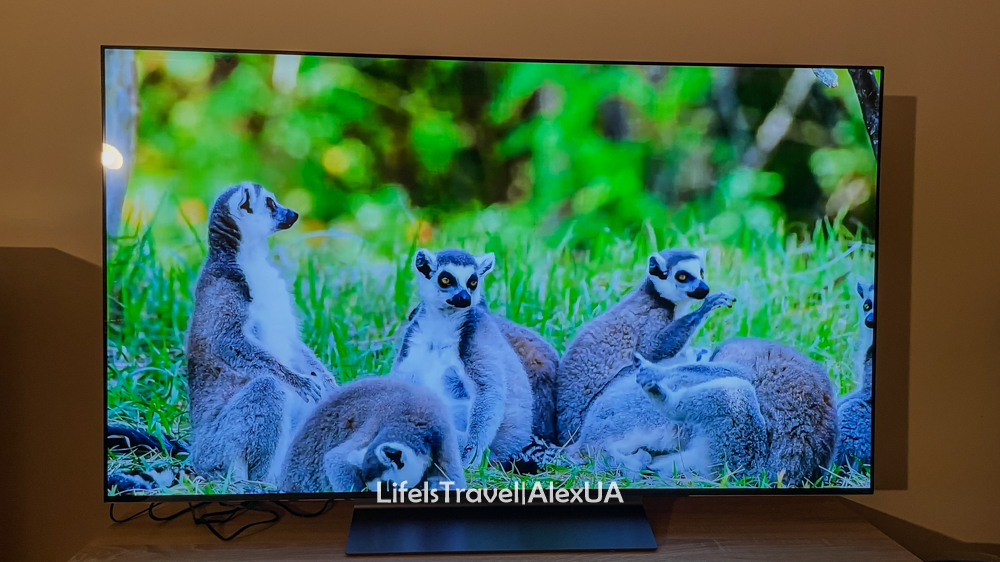Never thought I’d write a review about a TV, but here we are. I’m not a fan of games or movies, and I don’t use the TV as background noise. From April to mid-October, I usually don’t turn on the TV, spending that time at the cottage or traveling.
My previous 40-inch Sony TV lasted for about 20 years, so you can imagine my attitude toward this format of leisure. However, occasionally, I do feel like watching movies in good quality or something about travels and adventures on YouTube. So, I decided it was time to invest in a decent TV.

From thorough market research to the purchase, it took several days. During this time, I answered several questions, in order of significance:
- Which technology to choose: QLED, OLED, miniLED?
- Which brand to choose?
- Screen size
- Technical specifications (screen refresh rate, resolution, inputs-outputs, sound)
- Design
- Price
It took several hours of reading reviews online and watching YouTube videos. In the end, I concluded that today’s leading TV manufacturers are LG, SONY, Samsung, TCL, and Panasonic.
I delved deeper into each company and ruled out the Chinese (TCL), Panasonic, and Samsung. I settled on LG and SONY as pioneers in TV technologies.
Now, about technologies: I had to choose between QLED, OLED, and something in between – mini LED.

Advantages and disadvantages of each technology
OLED (Organic Light-Emitting Diode):
OLED TVs provide true black because each pixel can completely turn off. This ensures excellent contrast and black depth. OLED TVs have a wide viewing angle, with the image always clear and bright, regardless of the viewing angle.
These TVs are thinner, with a more progressive, innovative design. OLED TVs don’t have issues with uneven backlighting and color artifacts that QLED TVs may have. The drawback can be considered lower brightness compared to QLED technologies, though this drawback is minimized in top models. The main downside is the price. OLED technology is more expensive compared to QLED.
QLED (Quantum Dot Light Emitting Diode):
TVs with quantum dot technology. The main advantage is that they are brighter compared to OLED TVs and more affordable due to inexpensive manufacturing technology. Brightness allows watching programs even in daylight.
So, if the price is a crucial criterion for you, choose QLED TVs – they are significantly cheaper, especially for larger sizes. Top models also have decent quality. The downside is considered lower image quality. Instead of black, you’ll see 50 shades of gray and halos around images when watching movies at night. The picture is less realistic and less deep, but not as critical as many claim.

What I Ultimately Chose
After careful consideration, weighing all the pros and cons, I settled on the cutting-edge OLED technology. While price was a factor in my decision, it wasn’t the top priority. More crucial were picture quality without compromise, good sound, a 120Hz screen refresh rate to avoid flickering, modern design, 4K resolution, and a user-friendly interface.
Another insight after studying the market is related to the price. The higher the price, the higher the quality. It’s almost a linear relationship. Good TVs start from $1000 for a 50–55 inch diagonal. Anything below would be a clear compromise. TVs in the range of $1700–2000 will offer everything you need, including top-notch picture quality.
The market leaders for OLED technology TVs are LG and Sony. I chose between them.
In the end, I bought the LG C3, a 55-inch screen model (approximately 140 cm diagonally). The first impression of the TV was a wow-effect from everything: immersive sound, realistic picture, design, and screen size.
The LG C3, a Smart TV released in 2023, has an AI-based processor, Bluetooth, and Wi-Fi, and runs on the WebOS operating system, considered one of the most successful according to reviews. The design is strict and minimalist – a thin screen and a beautiful metal stand. It looks much more pleasing than four legs in cheaper models. Behind the thin screen, there is a thickness containing all the technical components. Everything is perfectly hidden, and the inputs-outputs are discreetly located on the side, maintaining an overall simplicity.
My main concern was about sufficient brightness to watch programs in daylight. Fortunately, the concerns were not confirmed – during the day, the TV shows close to ideal, with nothing to complain about. Perhaps cheaper models suffer from lower picture quality in daylight, but here, everything is top-notch. However, in winter, we have limited daylight in our apartment. In summer, I don’t watch TV at all.
What do I watch? I watch the morning news or something informative on YouTube, and in the evening, movies and series – not every day, but two to four times a week, as I neither have the desire nor time for more. I often watch sports – mainly extreme sports, but I can also enjoy football.
Conclusions:
OLED technology is the top that other technologies are unlikely to reach in the foreseeable future. It’s the maximum available today, and I consider the slightly higher price justified. High contrast, perfect picture quality, and realistic colors create a presence effect.
If you want maximum enjoyment and are willing to pay about 30-50% more than for regular QLED or miniLED TVs, then go for OLED. Choose LG or Sony models. It’s said that Sony acquired a similar technology from LG. So, the leader is evident.
Samsung competes reasonably well with the leaders, but it still lags a bit behind them with its QD technology.
The strengths of the LG C3 TV include not only perfect video and photo quality but also clean, powerful sound with good bass and high frequencies. The total output of 40W (20W per channel) allows not needing external speakers or a soundbar, although I have that option.
Apps – there are many apps for watching videos and movies, including Netflix, Megogo, YouTube, and a few others. You can download gaming apps, music apps, or apps tailored to your interests.
I have a moderately priced dual-band router at home, and there are no delays in viewing even on weekends when internet usage is at its peak.
Now, I watch movies more often in the evenings, although I try not to overdo it.